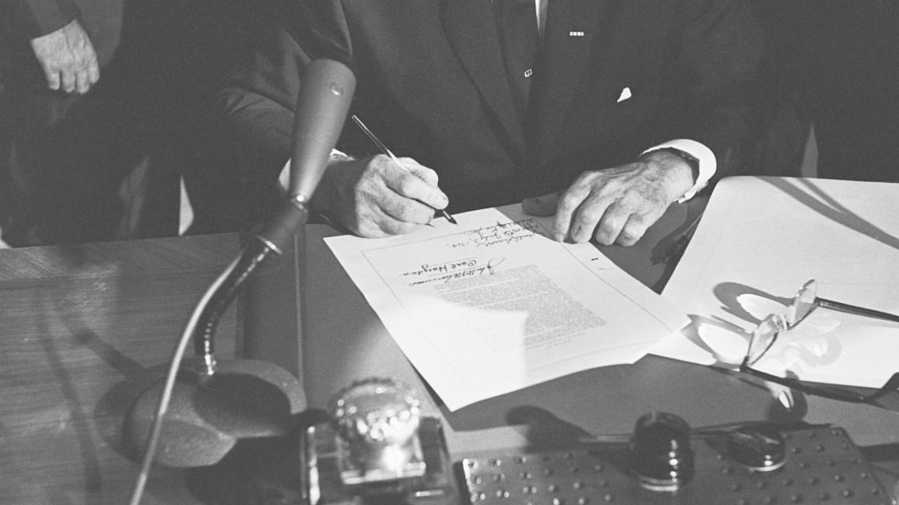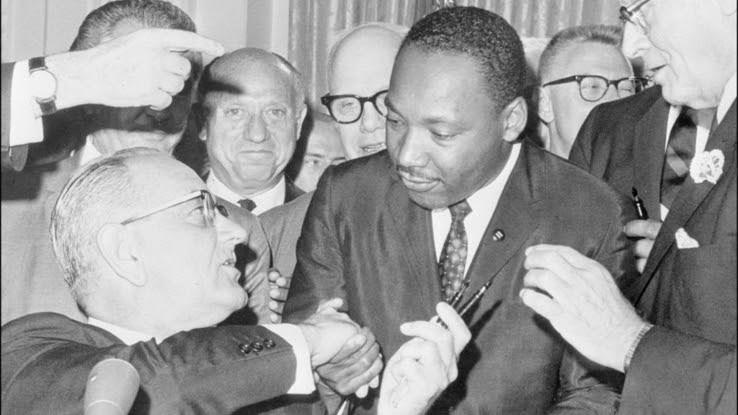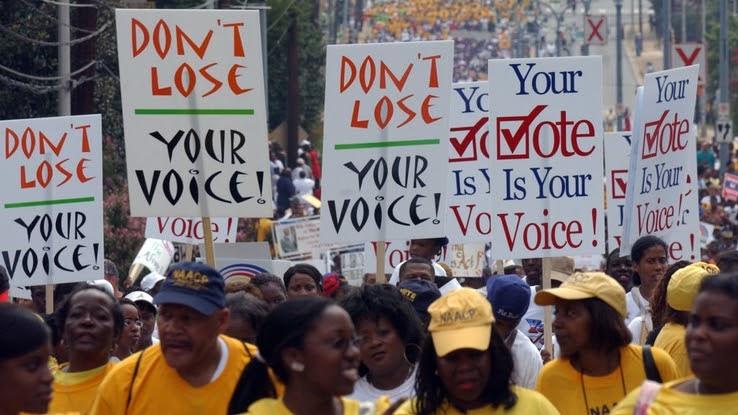58 Years Later: What Was the Civil Rights Act of 1964?

The Civil Rights Act of 1964 sought to end much of the discrimination that was pervasive, and legal, in 1960s America. Title VII of the Civil Rights Act specifically “bars employment discrimination based on race, religion, national origin and sex” — and it grants protection based on gender identity and sexual orientation.
Over 50 years later, the Civil Rights Act continues to protect countless individuals regardless of their ethnicity, culture, or creed. To appreciate the full scope — and the lasting legacy — of the Civil Rights Act of 1964, it’s important to look back and understand what led up to its momentous enactment.
Who Signed the Civil Rights Act of 1964?
When the American Civil War ended on April 8, 1865, the government passed the 13th, 14th and 15th Amendments to abolish slavery, grant formerly enslaved people U.S. citizenship and provide these new citizens the right to vote. However, in the decades that followed, numerous states, especially those in the South, created untold “legal” obstructions, from literacy tests to grandfather clauses, to stop Black Americans from voting and exercising the rights that were codified in those amendments.

By the time President John F. Kennedy entered the White House in 1961, Black leaders like Martin Luther King Jr., Rosa Parks and others made it clear that real change was needed to protect Black Americans and their rights. At first, President Kennedy avoided any steps to end segregation, but, by June of 1963, he outlined a civil rights bill that would not only end segregation but also restore — and protect — Black Americans’ right to vote. President Kennedy was tragically assassinated on November 11 of the same year, prompting his vice president and successor Lyndon B. Johnson to pass the bill in his stead.
Which Provisions Did the Civil Rights Act of 1964 Include?
The Civil Rights Act of 1964 as we know it today included numerous provisions: It banned voter registration requirements, like literacy tests and poll taxes, and aimed to end discrimination and segregation in public schools, trade unions, institutions that did business with the federal government and businesses that participate in interstate commerce. Additionally, the act also banned discrimination when it came to federal assistance program eligibility.

Opposition to the bill was fierce. Southern congressmen called it a violation of individual and state rights, and there were numerous attempts to sabotage the bill with so-called “poison pill” amendments — additions to a law intended to turn other lawmakers against it. One such amendment was proposed by Congressman Howard W. Smith of Virginia. He opposed both segregation and women’s rights but figured that, by introducing language into the bill banning discrimination based on sex as well as race, color, religion and national origin, he could sink the bill.
Much to Smith’s chagrin, President Johnson and Congress were determined to pass the bill anyway, despite shakier support for the language based on sex. While a group of senators held the longest filibuster in U.S. history — 60 days in total — to prevent the bill from becoming law, deals were made behind the scenes to win over opponents, and the bill moved to Johnson’s desk. Martin Luther King Jr., who was in the room with the president when he signed the bill into law, described that moment as “a second emancipation.”
What Happened in the Wake of the Act’s Enactment?
Just because the bill passed, that didn’t mean all of the opposition suddenly vanished. In fact, in the wake of its enactment, the act was brought all the way to the Supreme Court, where the justices confirmed it to be constitutional. As a result, white segregationists staged protests, committed acts of violence and voted a slew of pro-segregation lawmakers into office. Johnson, a Democrat, famously mused, “It is an important gain, but I think we just delivered the South to the Republican Party for a long time to come.”

On the flip side, the law also led to the passage of further landmark pieces of legislation, including the Voting Rights Act of 1965, which further strengthened protections against discriminatory voting laws, and the Fair Housing Act of 1968, which made discrimination in selling, renting or buying property illegal. Eventually, the act itself was amended in order to extend protections to seniors and disabled Americans, and, under Title IX, women* gained protection from discrimination based on sex in education programs or activities that receive federal financial assistance, including sports.
*At the time of the amendment’s addition, the aim was to put men and women on equal footing, but, today, the Supreme Court’s reading of the Civil Rights Act seems more poised to protect folks of all genders.
What Is the Act’s Legacy Today?
On June 15, 2020, the Supreme Court ruled on whether or not Title VII protects LGBTQ+ workers from workplace discrimination. Thanks to the 6-3 majority ruling, Title VII’s language now firmly applies to discrimination based on sexual orientation and gender identity. For the majority, Justice Neil M. Gorsuch wrote, “An employer who fires an individual merely for being gay or transgender defies the law.”

The ruling is a landmark for many reasons, but chief among them is that this was the first major case that outrightly protected transgender rights. Before, it was legal in more than half of the states to fire workers for being gay, bisexual, transgender or queer. That is, even though gay marriage has been the law of the land since 2015, LGBTQ+ folks in some states could get married over the weekend — and then fired on Monday, simply for living openly and truthfully with their same-sex spouse.
“This is a simple and profound victory for [LGBTQ+] civil rights,” Columbia law professor Suzanne B. Goldberg told The New York Times. “Many of us feared that the court was poised to gut sex discrimination protections and allow employers to discriminate based on sexual orientation and gender identity, yet it declined the federal government’s invitation to take that damaging path.”
Of course, despite these victories, the Civil Rights Act of 1964 hasn’t fully reconciled inequality in America. As the murder of George Floyd and many other Black Americans at the hands of police has shown, people in the United States still get treated in fundamentally different ways based on skin color. Additionally, inequality continues to stem from laws and practices that, in the past, expressly prevented Black Americans from owning property and advancing financially.
Additionally, the Civil Rights Act itself has also been weakened by certain court rulings, such as Shelby County v. Holder, wherein the court ruled that states and counties with a history of discriminatory voting laws no longer needed clearance from the federal government to change their voting laws. Needless to say, voter purges, stricter voter ID laws, rollbacks on early voting and registration and other forms of voter suppression emerged, making it harder for people of color to vote. Despite these shortcomings, however, the Civil Rights Act of 1964 has cemented its place as a quintessential piece of legislation — one that aims to create a better life for all Americans, even if we still have quite a bit of work to do to make that vision a reality.





